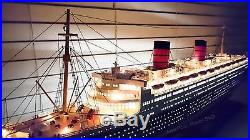
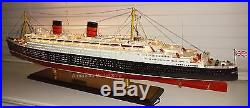
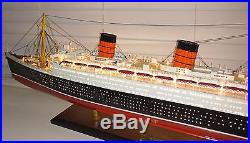
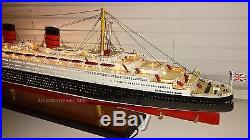
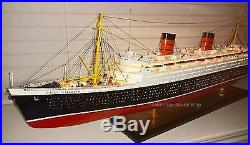
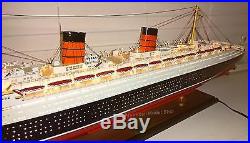


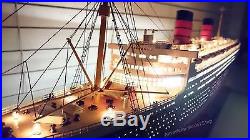
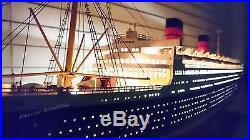
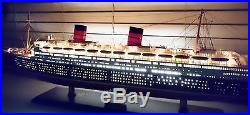

Handmade item The model is 100% scratch built with planks on frame construction method from the drawings. The hull is made of wood and painted. This model is not a kit and ready for display. Model comes with a display base and a brass name plate as shown photos. Specifications: 39.37L x 5.11W x 11.81H (inch) or 100L x 13W x 30H (cm) Brand new product. History of RMS Queen Elizabeth. RMS Queen Elizabeth was an ocean liner operated by the Cunard Line. With her running mate Queen Mary, she provided luxury liner service between Southampton, the United Kingdom, and New York City, the United States, via Cherbourg, France. While being constructed, in the mid-1930s by John Brown and Company at Clydebank, Scotland, she was known as Hull 552 but when launched, on 27 September 1938, she was named in honour of Queen Elizabeth, who was then Queen Consort to King George VI and in 1952 became the Queen Mother. She first entered service in February 1940 as a troopship in World War II, and it was not until October 1946 that she served in her intended role as an ocean liner. With the decline in the popularity of the transatlantic route, both ships were replaced by Queen Elizabeth 2 in 1969. In 1972, while undergoing refurbishment in Hong Kong harbour, she caught fire under mysterious circumstances and was capsized by the water used to fight the fire. The official contract between Cunard and government financiers was signed on 6 October 1936. Queen Elizabeth was built on slipway four at John Brown & Company in Clydebank, Scotland. During her construction she was more commonly known by her shipyard number, Hull 552. The interiors were designed by a team of artists headed by the architect George Grey Wornum. Due to the outbreak of World War II, these two dates were postponed. On 29 December her engines were tested for the first time, running from 0900 to 1600 with the propellers disconnected to monitor her oil and steam operating temperatures and pressures. Maiden voyage At the start of World War II, it was decided that as Queen Elizabeth was so vital to the war effort that she could not have her movements tracked by German spies operating in the Clydebank area. Therefore, an elaborate ruse was fabricated involving her sailing to Southampton to complete her fitting out. Another factor prompting Queen Elizabeth’s departure was the necessity to clear the fitting out berth at the shipyard for the battleship HMS Duke of York, which was in need of its final fitting-out. Only the berth at John Brown could accommodate the King George V-class battleship’s needs. A minimal crew of four hundred were assigned for the trip; most were signed up for a short voyage to Southampton from Aquitania. The names of Brown’s shipyard employees were booked to local hotels in Southampton to give a false trail of information and Captain John Townley was appointed as her first master. Townley had previously commanded Aquitania on one voyage, and several of Cunard’s smaller vessels before that. Townley and his hastily signed-on crew of four hundred Cunard personnel were told by a Cunard representative before they left to pack for a voyage where they could be away from home for up to six months. By the beginning of March 1940, Queen Elizabeth was ready for her secret voyage. Her Cunard colours were painted over with battleship grey, and on the morning of 3 March she quietly left her moorings in the Clyde where she proceeded out of the river and sailed further on down the coast where she was met by the King’s Messenger, who presented sealed orders directly to the captain. Captain Townley discovered that he was to take the untested vessel directly to New York without stopping, without dropping off the Southampton harbour pilot who had embarked on Queen Elizabeth from Clydebank and to maintain strict radio silence. Later that day at the time when she was due to arrive at Southampton, the city was bombed by the Luftwaffe. After a crossing taking six days, Queen Elizabeth had zigzagged her way across the Atlantic at an average speed of 26 knots avoiding Germany’s U-boats, where she arrived safely at New York and found herself moored alongside both Queen Mary and the French Line’s Normandie. This would be the only time all three of the world’s largest liners would be berthed together. This included port officials. World War II Queen Elizabeth left the port of New York on 13 November 1940 for Singapore to receive her troopship conversion. After two stops to refuel and replenish her stores in Trinidad and Cape Town, she arrived in Singapore’s Naval Docks where she was fitted with anti-aircraft guns, and her hull repainted black, although her superstructure remained grey. As a troopship, Queen Elizabeth left Singapore on 11 February, and initially she carried Australian troops to operating theatres in Asia and Africa. After 1942, the two Queens were relocated to the North Atlantic for the transportation of American troops to Europe. Queen Elizabeth and Queen Mary were used as troop transports during the war. Their high speeds allowed them to outrun hazards, foremostly German U-boats, allowing them to typically travel without a convoy. During her war service as a troopship Queen Elizabeth carried more than 750,000 troops, and she also sailed some 500,000 miles (800,000 km). Her captains during this period were the aforementioned John Townley, Ernest Fall, Cyril Gordon Illinsworth, Charles Ford, and James Bisset. Post-war career Following the end of World War II, her running mate Queen Mary remained in her wartime role and grey appearance, except for her funnels, which were repainted in the company’s colours. For another year she did military service, returning troops and G. Brides to the United States. Queen Elizabeth, meanwhile, was refitted and furnished as an ocean liner at the Firth of Clyde Drydock in Greenock by the John Brown Shipyard. Six years of war service had never permitted the formal sea trials to take place, and these were now finally undertaken. During the trials, her majesty Queen Elizabeth took the wheel for a brief time and the two young princesses recorded the two measured runs with stopwatches that they had been given for the occasion. Despite similar specifications to her older sister Queen Mary, Elizabeth never held the Blue Riband, as Cunard White Star chairman Sir Percy Bates requested that the two ships not try to compete against one another. In 1955 during an annual overhaul at Southampton, England, Queen Elizabeth was fitted with underwater fin stabilizers to smooth the ride in rough seas. Two fins were fitted on each side of the hull. The fins were retractable into the hull to save fuel in smooth seas and for docking. While a troupe of invading men from a fictional European country cross the Atlantic to’war’ with the United States on a tow boat, they meet and pass the far larger Queen Elizabeth, and learn that New York City is closed due to an air raid drill. The men on the tow boat respond by loosing arrows at the two officers speaking from near the ocean liner’s bridge. Together with the Queen Mary, and in competition with SS United States, the Queen Elizabeth dominated the transatlantic passenger trade until their fortunes began to decline with the advent of the faster and more economical jet airliner in the late 1950s; As passenger numbers declined, the Queens became uneconomic to operate in the face of rising fuel and labour costs. However, this strategy did not prove successful due to her high fuel costs, deep draught (which prevented her from entering various island ports), and great width, preventing her from using the Panama Canal. The Elizabeth, as it was now called, actually opened to tourists before the Queen Mary (which opened in 1971) but it was not to last. The climate of southern Florida was much harder on the Queen Elizabeth than the climate of southern California was on the Queen Mary. Tung, head of the Orient Overseas Line, intended to convert the vessel into a university for the World Campus Afloat program (later reformed and renamed as Semester at Sea). The fact that C. Portions of the hull that were not salvaged were left at the bottom of the bay. The keel and boilers remained at the bottom of the harbour and the area was marked as “Foul” on local sea charts warning ships not to try to anchor there. It is estimated that around 4050% of the wreck was still on the seabed. In the late 1990s, the final remains of the wreck were buried during land reclamation for the construction of Container Terminal 9. Position of wreck: 22°19.717N 114°06.733E The Queen Elizabeth is surpassed only by the Costa Concordia in 2012 as the largest passenger shipwreck. The charred wreck was featured in the 1974 James Bond film The Man with the Golden Gun, as a covert headquarters for MI6. After the fire, Tung had one of the liner’s anchors and the metal letters “Q” and “E” from the name on the bow placed in front of the office building at Del Amo Fashion Center in Torrance, California, US that was intended to be the headquarters of the Seawise University venture, where they remain to this day. The charred remnants of her last ensign were cut from the flag pole and framed in 1972, and still adorn the wall of the officers’ mess of marine police HQ in Hong Kong. Parker Pen Company produced a special edition of 5,000 pens made from material recovered from the wreck in a presentation box and these are highly collectable. In Unlikely event if. The item “QUEEN ELIZABETH Ocean Liner 40 With Lights Handcrafted Wooden Ship Model NEW” is in sale since Saturday, October 15, 2016. This item is in the category “Toys & Hobbies\Models & Kits\Boats, Ships\Wooden”. The seller is “americanmodelship” and is located in Houston, Texas. This item can be shipped to United States, to Canada, to United Kingdom, DK, RO, SK, BG, CZ, FI, HU, LV, LT, MT, EE, to Australia, GR, PT, CY, SI, to Japan, to China, SE, KR, ID, to Taiwan, ZA, TH, to Belgium, to France, to Hong Kong, to Ireland, to Netherlands, PL, to Spain, to Italy, to Germany, to Austria, RU, IL, to Mexico, to New Zealand, PH, SG, to Switzerland, NO, SA, UA, AE, QA, KW, BH, HR, MY, BR, CL, CO, CR, PA, TT, GT, HN, JM.
